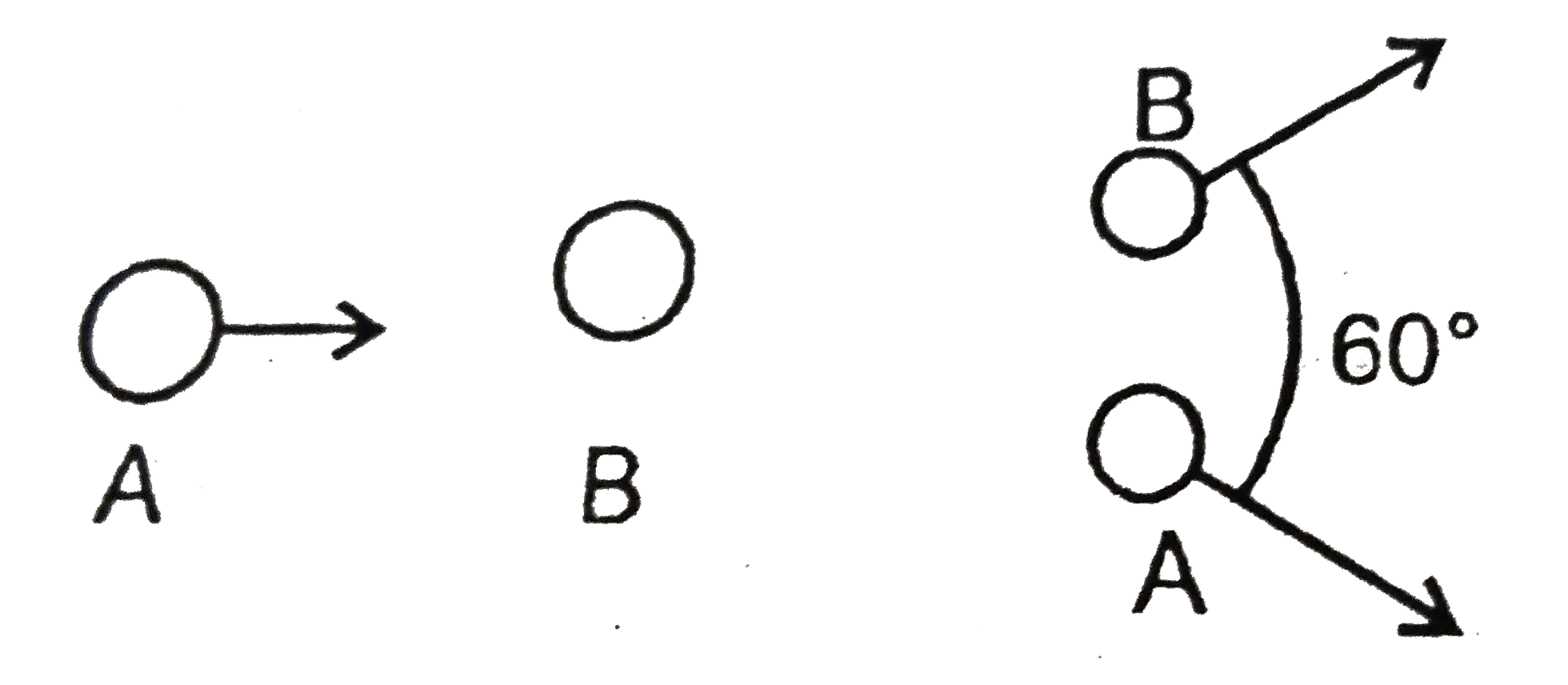After perfectly inelastic collision between two identical balls moving with same speed in different directions, the speed of the combined mass becomes half the initial speed. Find the angle between the two before collision.
60∘
45∘
120∘
30∘
To solve the problem, we need to analyze the situation before and after the perfectly inelastic collision between the two identical balls. Let's break it down step by step.
Step 1: Understand the Initial Conditions
We have two identical balls, each with mass m, moving with the same speed v but in different directions. Let's denote the angle between their velocities before the collision as θ.
Step 2: Apply Conservation of Momentum
In a perfectly inelastic collision, momentum is conserved. The total initial momentum →Pinitial must equal the total final momentum →Pfinal.
The initial momentum can be expressed as:
→Pinitial=→P1+→P2
where →P1=m→v1 and →P2=m→v2.
Step 3: Calculate the Magnitude of Initial Momentum
Since both balls have the same speed v and are moving at an angle θ to each other, we can find the magnitude of the resultant momentum using the law of cosines:
|→Pinitial|=√(mv)2+(mv)2+2(mv)(mv)cos(θ)
This simplifies to:
|→Pinitial|=mv√2+2cos(θ)=mv√2(1+cos(θ))=mv√4cos2(θ/2)=2mvcos(θ/2)
Step 4: Calculate the Final Momentum
After the collision, the two balls stick together and move with a speed of v2. Therefore, the final momentum is:
→Pfinal=(2m)(v2)=mv
Step 5: Set Initial and Final Momentum Equal
From conservation of momentum, we have:
2mvcos(θ/2)=mv
Dividing both sides by mv (assuming m≠0 and v≠0):
2cos(θ/2)=1
This simplifies to:
cos(θ/2)=12
Step 6: Solve for θ
Taking the inverse cosine:
θ/2=60∘⟹θ=120∘
Conclusion
The angle between the two balls before the collision is 120∘.
We have two identical balls, each with mass m, moving with the same speed v but in different directions. Let's denote the angle between their velocities before the collision as θ.
In a perfectly inelastic collision, momentum is conserved. The total initial momentum →Pinitial must equal the total final momentum →Pfinal.
→Pinitial=→P1+→P2
where →P1=m→v1 and →P2=m→v2.
Since both balls have the same speed v and are moving at an angle θ to each other, we can find the magnitude of the resultant momentum using the law of cosines:
|→Pinitial|=√(mv)2+(mv)2+2(mv)(mv)cos(θ)
This simplifies to:
|→Pinitial|=mv√2+2cos(θ)=mv√2(1+cos(θ))=mv√4cos2(θ/2)=2mvcos(θ/2)
After the collision, the two balls stick together and move with a speed of v2. Therefore, the final momentum is:
→Pfinal=(2m)(v2)=mv
From conservation of momentum, we have:
2mvcos(θ/2)=mv
Dividing both sides by mv (assuming m≠0 and v≠0):
2cos(θ/2)=1
This simplifies to:
cos(θ/2)=12
Taking the inverse cosine:
θ/2=60∘⟹θ=120∘
The angle between the two balls before the collision is 120∘.
Topper's Solved these Questions
- CENTRE OF MASS, IMPULSE AND MOMENTUMBOOK - DC PANDEY ENGLISHCHAPTER - CENTRE OF MASS, IMPULSE AND MOMENTUMEXERCISE - Only one option is correct for JEE Advanced
60 Videos
- CENTRE OF MASS, IMPULSE AND MOMENTUMBOOK - DC PANDEY ENGLISHCHAPTER - CENTRE OF MASS, IMPULSE AND MOMENTUMEXERCISE - More a than one option is Correct
1 Videos
- CENTRE OF MASSBOOK - DC PANDEY ENGLISHCHAPTER - CENTRE OF MASSEXERCISE - Medical entrances gallery
27 Videos
- CENTRE OF MASS, LINEAR MOMENTUM AND COLLISIONBOOK - DC PANDEY ENGLISHCHAPTER - CENTRE OF MASS, LINEAR MOMENTUM AND COLLISIONEXERCISE - Level 2 Subjective
21 Videos
Similar Questions
After a completely inelastic collision two objects of the same mass and same initial speed are found to move away together at half their initial speed. Find the angle between the initial velocities of the objects.
View SolutionAfter a totally inelastic collision, two objects of the same mass and same initial speeds are found to move together at half of their initial speeds. The angle between the initial velocities of the objects is
View SolutionAfter a totally inelastic collision, two objects of the same mass and same initial speeds are found to move together at half of their initial speeds. The angle between the initial velocities of the objects is
View SolutionAfter a totally inelastic collision, two objects of the same mass and same initial speeds are found to move together at half of their initial speeds. The angle between the initial velocities of the objects is
View SolutionTwo particles of equal masses moving with same momentum collide perfectly inelastically. After the collision the combined mass moves with half of the speed of the individual masses. The angle between the initial momenta of individual particle is
View SolutionTwo identical balls each moving with speed v at right angle to each other collide perfectly inelastically. Their speed after collision is
View SolutionConsider an oblique elastic collision between a moving ball and a stationary ball of the same mass. Both the balls move with the same speed after the collision. After the collision, the angle between the directions of motion of two balls is x degree. Find the value of x.
View SolutionTwo identical balls moving in opposite directions with speed 20 m/s and 25 m/s undergo head on perfectly inelastic collision. The speed of combined mass after collision is
View SolutionA smooth ball 'A' moving with velocity 'V' collides with another smooth identical ball at rest. After collision both the balls move with same speed with angle between their velocities 60∘. No external force acts on the system of balls.

The speed of each ball after the collision is
View SolutionA particle is projected from the ground with speed u at angle 60∘ from horizontal. It collides with a second particle of same mass moving with horizontal speed u in same direction at highest point of its trajectory. If collision is perfectly inelastic then find horizontal distance travelled by them after collision when they reached at ground
View Solution
